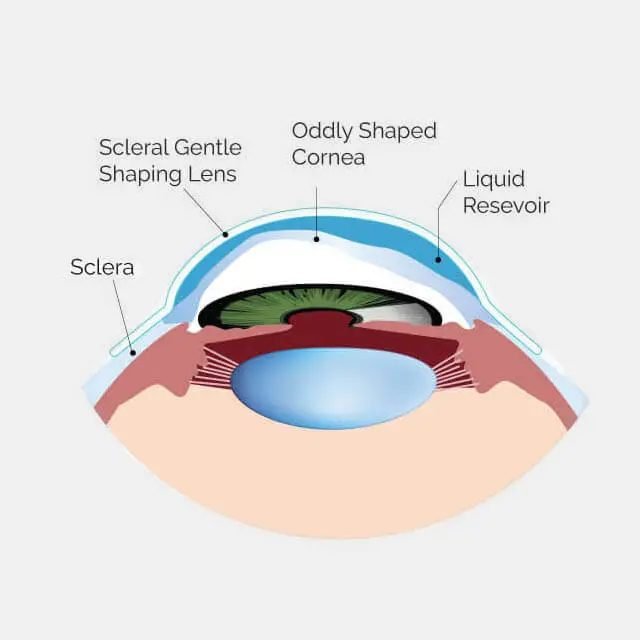The Pros and Cons of Scleral Lenses Compared to Regular Contact Lenses
Introduction
For individuals who require vision correction but prefer not to wear eyeglasses, contact lenses have long been a popular alternative. Among the many options available, scleral lenses stand out as a specialized type of contact lens designed for individuals with unique eye conditions or those seeking superior comfort and clarity. However, regular contact lenses remain the most commonly used type due to their accessibility and affordability. This article will explore the advantages and disadvantages of scleral lenses in comparison to regular contact lenses, helping individuals make an informed decision regarding which option best suits their needs.
Understanding Scleral Lenses and Regular Contact Lenses
Scleral Lenses
Scleral lenses are large-diameter, gas-permeable lenses that vault over the cornea and rest on the sclera, the white part of the eye. Unlike traditional contact lenses, which sit directly on the cornea, scleral lenses create a tear-filled reservoir between the lens and the cornea, providing enhanced hydration and comfort. They are particularly beneficial for individuals with keratoconus, severe dry eye syndrome, corneal irregularities, and post-surgical complications.
Regular Contact Lenses
Regular contact lenses, which include soft contact lenses and standard rigid gas-permeable (RGP) lenses, are designed to sit directly on the cornea. They come in a variety of materials, including hydrogel and silicone hydrogel, which allow for oxygen permeability and flexibility. These lenses are widely used for myopia (nearsightedness), hyperopia (farsightedness), astigmatism, and presbyopia correction.
Pros of Scleral Lenses
1. Superior Comfort and Moisture Retention
One of the biggest advantages of scleral lenses is their ability to retain moisture. Because they create a fluid-filled layer between the lens and the eye, they provide continuous hydration, making them an excellent choice for individuals with chronic dry eye syndrome. This moisture barrier helps reduce irritation and discomfort associated with standard contact lenses.
2. Better Vision Correction
Scleral lenses offer a more uniform optical surface than regular contact lenses, making them ideal for individuals with corneal irregularities such as keratoconus. The rigid material helps to create a smooth refractive surface, providing clearer and sharper vision compared to soft contact lenses, which conform to the shape of the eye.
3. Stability and Reduced Displacement
Due to their large size, scleral lenses are less likely to shift or become dislodged from the eye, making them particularly useful for individuals who participate in sports or lead active lifestyles. Unlike regular contact lenses, which can move around and cause blurry vision, scleral lenses remain stable on the eye, ensuring consistent visual clarity.
4. Longer Wearing Time
Because scleral lenses are designed to be more breathable and provide constant hydration, they can often be worn for longer periods without causing discomfort. This makes them suitable for individuals who require extended wear due to work demands or other commitments.
5. Protection for the Cornea
For individuals with sensitive or damaged corneas, scleral lenses act as a protective barrier against environmental irritants, reducing the risk of further damage or discomfort. This is particularly beneficial for post-surgical patients and those with corneal dystrophies.
Cons of Scleral Lenses
1. Higher Cost
One of the most significant drawbacks of scleral lenses is their cost. Because they are custom-made for each individual, they are considerably more expensive than regular contact lenses. The initial cost of fitting and purchasing scleral lenses can be a financial barrier for many people.
2. Longer Adaptation Period
Unlike soft contact lenses, which are typically easy to adapt to, scleral lenses require a longer adjustment period. The larger size and rigid nature of the lens can feel unusual at first, and some users may need weeks to fully acclimate to the sensation.
3. More Complex Care Routine
Scleral lenses require a more involved cleaning and maintenance routine compared to regular contact lenses. They must be filled with preservative-free saline before insertion and require specialized cleaning solutions to ensure they remain free of debris and bacteria. This can be time-consuming and inconvenient for some users.
4. Difficult Application and Removal
Due to their larger size, scleral lenses can be more challenging to insert and remove than regular contact lenses. Many users require specialized plungers or suction devices to aid in handling the lenses, which can be cumbersome for individuals who are new to wearing contact lenses.
5. Limited Availability and Specialist Fitting Required
Not all optometrists or ophthalmologists specialize in fitting scleral lenses. Finding an eye care professional with expertise in scleral lens fitting may be more challenging, leading to longer wait times and potentially higher consultation fees.
Pros of Regular Contact Lenses
1. Affordability
Regular contact lenses are significantly more affordable than scleral lenses. Soft contact lenses, in particular, are available in a wide range of options at various price points, making them accessible to a larger audience.
2. Ease of Use
Soft contact lenses are relatively easy to insert, remove, and handle, making them an excellent choice for first-time users. They conform to the shape of the eye and provide immediate comfort, reducing the adaptation period.
3. Wide Availability
Unlike scleral lenses, which require specialized fitting, regular contact lenses are widely available at most optometry clinics and online retailers. This makes them a convenient option for individuals who need quick replacements or frequent prescription updates.
4. Various Options for Different Needs
Regular contact lenses come in daily, biweekly, and monthly disposable options, allowing users to choose a wear schedule that best suits their lifestyle. Additionally, toric and multifocal lenses are available for individuals with astigmatism and presbyopia.
5. Minimal Maintenance
Daily disposable contact lenses, in particular, require little to no maintenance since they are discarded after a single use. This reduces the risk of infection and the need for an extensive cleaning routine.
Cons of Regular Contact Lenses
1. Increased Risk of Dryness and Discomfort
Soft contact lenses can absorb moisture from the eyes, leading to dryness and discomfort, especially in individuals who suffer from dry eye syndrome. This can make wearing regular contact lenses challenging for extended periods.
2. Less Stability
Unlike scleral lenses, which remain securely in place, regular contact lenses can shift or move around the cornea, leading to fluctuating vision and potential discomfort. This can be problematic for individuals with active lifestyles or those who engage in sports.
3. Shorter Wearing Time
Regular contact lenses, especially soft lenses, can become uncomfortable after prolonged wear due to reduced oxygen permeability. This limits the number of hours they can be worn comfortably each day.
4. Susceptibility to Deposits and Bacteria
Regular contact lenses can accumulate protein deposits and bacteria over time, increasing the risk of eye infections. Proper cleaning and hygiene practices are necessary to ensure eye health, which can be a hassle for some users.
Conclusion
Both scleral lenses and regular contact lenses offer distinct advantages and disadvantages depending on an individual’s eye condition, lifestyle, and budget. Scleral lenses provide superior vision correction, moisture retention, and stability, making them ideal for individuals with corneal irregularities or severe dry eye syndrome. However, they come with a higher cost, a more complex care routine, and a longer adaptation period. On the other hand, regular contact lenses are more affordable, widely available, and easier to use but may cause dryness and discomfort for some wearers. Consulting with an eye care professional can help determine which option is best suited for one’s unique vision needs and lifestyle preferences.
https://visionspace.com.my/scleral-lenses-non-surgical-solution-for-corneal-scarring/



